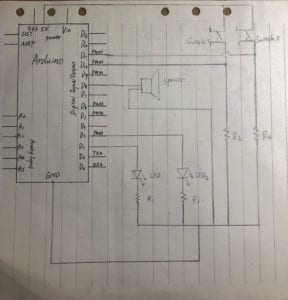Tasks
- Circuit 1: Fade
Schematic

Video
Process
Before I started building the circuit, I asked my partner Caren if she’d like to connect it to my computer because I wanted to practice coding and she agreed. But then I found I just needed to open the code in Examples. I thought it was easy, but Caren reminded me to select the proper Boarder and Port which I forgot to do. Thanks to her. All other things just run smoothly because this circuit only consisted very few components. We connected them according to the schematic.
- Circuit 2: toneMelody
Schematic
Video
Process
This circuit was also done smoothly because it is similar to Circuit 1. But during the process we didn’t unplug the adapter and one teaching assistant came to warn us. Well, I will pay attention to it next time.
- Circuit 3: Speed Game
Schematic

Video
Process
To be honest, this circuit was a total mess. When we finally finished building it, there popped up a prompted box saying something used too much power. Anyhow, it didn’t work. So we turned to that teaching assistant. He unplugged the adapter and found it hot, then he checked our messy cables carefully and found one electric wire connected the power source to ground and formed a short circuit. He also helped us unplug 2 useless wires to simplify our circuit. I think the cause of our false is our terrible division of labour and messy order of connecting components, which need to be arranged reasonably next time.
Questions
1. Nowadays, technology has penetrated into our daily lives and no one can live without it. There are so many examples, household appliances, vehicles, PCs, smart phones, etc. But what we have access to in our daily lives are mostly multimedia computers and intermediate computers, which have strong output functions but low input functions. When we build the circuits in interaction lab, we can use Arduino, which belongs to another type of computer: Microcontroller. It can “capture and convey a person’s expression”apart from “trying to imitate the autonomy of human beings” so that “the gap between the physical world and the virtual world” can be bridged.
2. If I have 100000 LEDs of any brightness and color at my disposal, I would like to open an LED art gallery where innumerable “celebrated paintings” all over the world composed of LEDs were exhibited here. They can not only change from one painting to another everyday, but also turn static paintings into dynamic ones with some creative ideas. Although it’s of no practical use, but it can be a tourist attraction which becomes different everyday.
Reference
https://drive.google.com/file/d/1uviCK0V71cQpA76PV9PK03Df14vcsd0y/view